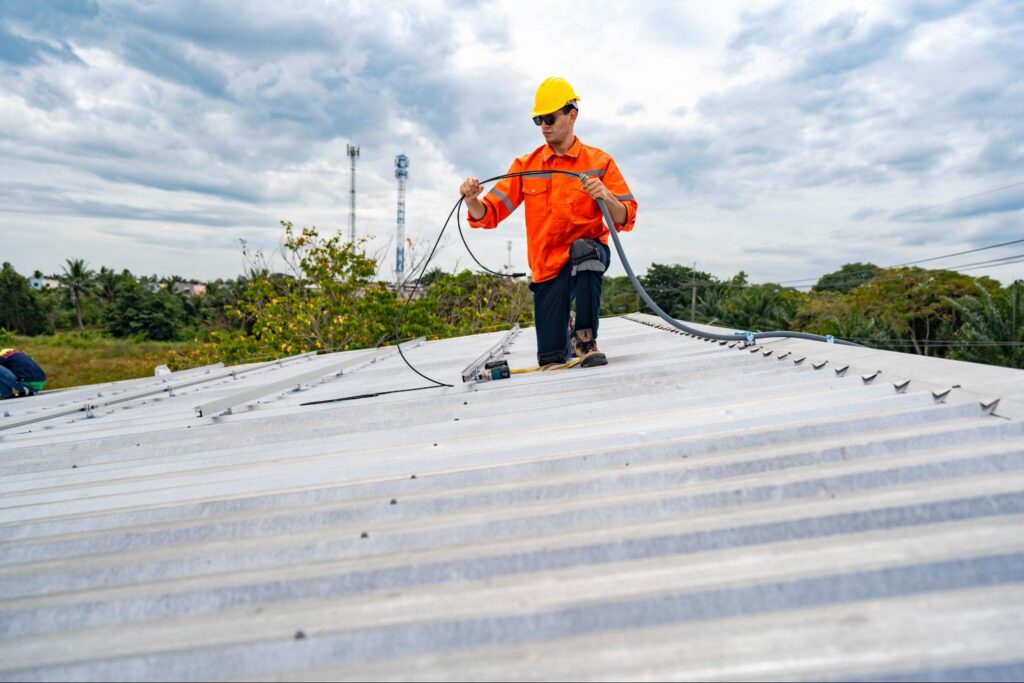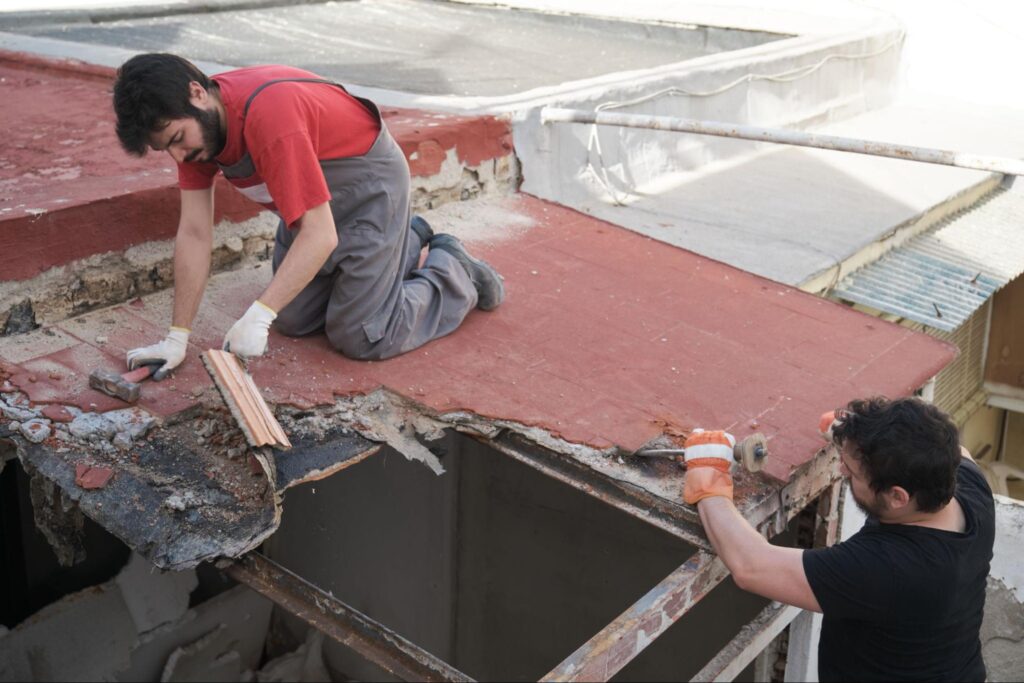
A home’s roof isn’t just part of the structure; it’s a shield that keeps everything inside safe and secure. Over time, even the toughest roofing materials start to break down. Many homeowners don’t think about their roofs until a leak appears or shingles start flying off. Waiting until something goes wrong costs more, creates stress, and puts your home at risk. A long-term roof replacement schedule isn’t just helpful; it’s a key strategy for savvy homeowners to stay one step ahead.
Why a Roof Replacement Schedule Matters
Planning your roof’s future is more than just being prepared; it’s about control. Instead of reacting to disasters, you steer the timeline, the cost, and the outcome. Roofs have predictable life cycles, but too many people ignore the warning signs until it’s too late. A roof replacement schedule turns guesswork into a plan that protects your home and budget.
Your Roof Isn’t Built to Last Forever
Roofs break down like anything exposed to sun, wind, and rain. Asphalt shingles may last 20 years, while metal roofs can last up to 40 years. However, even the best roof eventually wears out. Minor damage can build up over time and become a major issue. Most leaks and rot happen after years of slow, hidden decay. Replacing your roof on time avoids that downward spiral.
Predictable Maintenance Saves You Money
Minor repairs now prevent substantial expenses later. A roof replacement schedule helps you handle costs before they spike. Emergencies are always more expensive than planned replacements. Roofers charge more during storms or peak seasons. You also avoid interior damage, such as ruined drywall or moldy insulation.
Home Value and Insurance Depend on Roof Health
Insurance companies often reduce coverage for aging roofs. They may even cancel policies if the roof looks worn. On the other hand, a newer roof lowers your premium. Buyers also consider the age of the roof during home inspections. A documented schedule shows them you’ve maintained your property.
Understanding the Roof Replacement Timeline
A roof replacement schedule starts with knowing what to expect. Different materials have different lifespans. Climate, roof design, and even tree coverage play a role. With this in mind, it’s easier to set realistic targets.
Life Expectancy by Roofing Material
Not all roofs age the same way. Asphalt shingles are an affordable option, but they typically last 15–25 years. Metal roofs can last 40 years or more with care. Tile and slate often last past 50 years, but they cost more upfront. Wood shakes last between 20 and 30 years if properly maintained. Your material choice affects everything from replacement timelines to savings.
Factors That Affect Roof Longevity
Quality installation is key. A poorly installed roof will fail more quickly, regardless of the material. Storms, snow, and direct sunlight also shorten lifespan. Homes in coastal or humid areas need more frequent inspections. Good attic ventilation and insulation slow wear from the inside out. Each of these variables should be part of your schedule planning.
How to Create a Long-Term Roof Replacement Schedule
You can’t build a reliable schedule without knowing your starting point. Assessing the current condition of your roof is the first step. From there, you can work with professionals or use digital tools to track repairs and plan future replacement dates. A proactive schedule is like a maintenance calendar with real consequences.
Start With a Professional Roof Assessment
Every long-term schedule starts with facts. Have a roofer inspect for damage, weak spots, and structural issues. They’ll check flashing, shingles, gutters, and attic ventilation. You’ll get a detailed report that helps set realistic expectations. Keep records from each visit to build a timeline.

Use Time-Based and Condition-Based Triggers
Mark the date of your roof’s installation, the warranty period, and the target replacement year. Record signs like missing shingles, mold, or water damage. Combine time-based goals with condition alerts to stay on top of changes and ensure timely updates. If a bad storm hits, do an unscheduled checkup—store pictures and notes in folders or digital trackers.
Involve the Same Roofing Company Over Time
Using one trusted roofer keeps things simple. They track your home’s history and know which issues keep recurring. They can recommend upgrades as materials improve. Long-term relationships often lead to better pricing and priority service. It also removes guesswork when you’re unsure who to call.
Long-Term Cost Planning for Roof Replacement
Many homeowners put off replacements due to the cost. But spreading expenses over time makes them more manageable. Planning for costs instead of reacting to them changes the whole experience, so you won’t feel caught off guard when the time comes.
Understand the Full Cost of a Roof Replacement
The cost depends on materials, square footage, and the complexity of the roof. Shingles are less expensive than slate or metal but require more frequent replacement. You’ll also pay for labor, removal of the old roof, and permits. Prices shift depending on the market and region. Get quotes every few years to stay updated.
Save Over Time Instead of All at Once
Set aside money in a dedicated home repair fund. It doesn’t have to be huge, just consistent. Even saving a little each month adds up by year ten or 15. This cushions you against price jumps and labor shortages. It also prevents you from needing emergency financing.
Explore Flexible Financing Options
If savings fall short, there are still options. Home equity loans and lines of credit often have low rates. Some roofing companies offer zero-interest financing or payment plans. Read the terms carefully to avoid high fees. Warranties may also cover partial costs if the installation was recent.
Seasonal Checks in a Roof Replacement Schedule
Regular checkups give you peace of mind. They catch problems before they get worse. Including these tasks in your long-term roof replacement schedule keeps things running smoothly year after year.
What to Inspect Each Spring and Fall
After storms, look for broken or curling shingles. Check flashing near chimneys and roof valleys. Clear debris from gutters and roof edges. Inside, check the ceilings and attic for damp spots or mold. Addressing minor issues now avoids serious repairs later.
Prevent Damage From Branches and Debris
Nearby trees pose hidden threats. Overhanging branches rub away roofing granules and hold moisture. Leaves trap water and clog drainage paths. Trimming back limbs helps prevent roof rot. Schedule this as part of spring yard maintenance.
Roof Replacement Schedule Red Flags That Require Action
Some roofing issues need prompt attention to prevent them from escalating. Including fast-response steps in your roof replacement schedule gives you a real advantage. Identifying early warning signs puts you in control and limits the risk of larger repairs. Staying alert helps you act with confidence and protect your investment.
Interior Signs That Point to Roof Failure
Ceiling stains are often the first visible clue that moisture is seeping in. A musty-smelling attic or damp insulation also signals it’s time for a closer look. Catching these signs early allows quick repairs that keep your structure dry and intact. Even small drips, if handled promptly, can save walls and woodwork from further damage. If you notice daylight peeking through roof boards, it’s a clear sign that your roof needs attention. Taking action right away preserves the health of your home.
Shingle Debris in Gutters and Driveways
Spotting granules in gutters or around your home is a helpful heads-up. These tiny bits show that your shingles are naturally aging. Catching this early gives you time to plan repairs or replacements without pressure. If entire shingles appear in the yard, it’s an opportunity to schedule an inspection and stay ahead of the issue. Granule loss reduces sun protection, but addressing it promptly keeps your roof performing well. Regular checks can extend your roof’s lifespan and avoid costly surprises.

How a Roof Replacement Schedule Affects Energy Use
Many homeowners overlook the connection between their roofs and energy use. A planned roof replacement schedule not only prevents leaks but also helps maintain indoor comfort and lower utility bills. As materials degrade, they lose their ability to reflect sunlight or insulate properly. Old shingles or underlayment can trap heat in summer or let warm air escape in winter. Staying on schedule with replacement keeps your roofing system energy-efficient throughout its lifespan.
Modern Roofing Materials Offer Built-In Efficiency
Today’s roofing systems are built to do more than protect. Cool-roof shingles reflect UV rays, reducing heat absorption. Metal roofs often include reflective coatings that improve thermal performance. When timed correctly, upgrades can be made without extra structural changes. Replacing your roof on schedule allows you to switch to these better-performing options. You gain energy savings and long-term value without waiting for failure to justify the change.
Roof Replacement Schedule and Indoor Air Quality
Few people connect the condition of their roof to the air they breathe. However, a compromised roof can lead to trapped moisture, hidden mold, and pest entry. Following a roof replacement schedule protects your structure and ensures the health of your family. Keeping the roof sealed and dry limits humidity spikes and stops allergens from spreading. A dry attic and properly sealed roofline help maintain a clean indoor environment year-round.
Mold and Moisture Travel Fast After Roof Damage
When water passes a worn roof, it doesn’t stay in one spot. Damp insulation breeds mold that circulates through vents and ducts. That can trigger asthma, allergies, or persistent respiratory issues. Regular roof checks and timely replacement prevent mold growth before it starts. Addressing roofing problems early helps keep indoor air fresh and safe for everyone in the home.
Roof Replacement Schedule and Home Resale Value
A home with a documented roof replacement schedule stands out on the market. Buyers feel confident when they know the roof is in good shape. A predictable schedule provides records, inspections, and repair logs that reassure them that the home was maintained with care. It also shortens inspection time, reduces last-minute negotiations, and can justify a higher asking price. A roof schedule is a quiet selling tool that speaks volumes.
Buyers Trust Homes With Proven Maintenance History
Home inspections often slow deals down. However, when buyers see proof of regular roof assessments and timely repairs, they’re more likely to trust what they’re buying. It demonstrates responsibility and attention to upkeep, alleviating concerns about unexpected leaks or future costs. Homes with strong records sell faster and closer to the asking price.
Why a Roof Replacement Schedule Deserves Your Attention
A roof replacement schedule isn’t just a checklist; it’s a sign that you’re thinking ahead and not reacting late. Giving your roof the attention it deserves is one of the most effective ways to care for your home. Taking small steps today can prevent stress, cost, and disruption.
Want more smart roofing insights? Visit the Faircloth Roofing, Inc. blog for tips on staying ahead.






